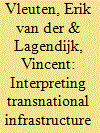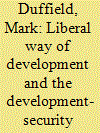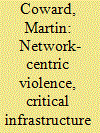|
|
|
Sort Order |
|
|
|
Items / Page
|
|
|
|
|
|
|
| Srl | Item |
| 1 |
ID:
159787


|
|
|
|
|
| Summary/Abstract |
This article provides a genealogy of the governance of critical infrastructure in Canada. We focus in particular on a largely unknown and unexamined civil defense initiative introduced during World War II that sought to count, categorize and, under declaration of a national emergency, directly protect what were then known as ‘vital points’ from sabotage. Our analysis recounts major episodes and turning points in the deployment of this organizational apparatus by the various institutions responsible for civil defence and emergency management in which it was embedded. In the latter sections of this article we show how the problem of critical infrastructure was decoupled from the exercise of exceptional emergency power and reconstituted in the form of what we refer to as ‘coordinated preparedness’, through which the governance of critical infrastructure is accomplished in ways that are compatible with the constitutionalization of Canada’s emergency power. We conclude by considering what the governance of critical infrastructure in Canada reveals for critical understandings of emergencies and emergency power.
|
|
|
|
|
|
|
|
|
|
|
|
|
|
|
|
| 2 |
ID:
185225


|
|
|
|
|
| Summary/Abstract |
The COVID-19 pandemic has ushered in a wave of cyberattacks targeting the healthcare sector, including against hospitals, doctors, patients, medical companies, supply chains, universities, research laboratories, and public health organizations at different levels of jurisdiction and across the public and private sectors. Despite these concerns, cybersecurity in Canadian healthcare is significantly understudied. This article uses a series of illustrative examples to highlight the challenges, outcomes, and solutions Canada might consider in addressing healthcare cybersecurity. The article explores the various rationales by which Canadian healthcare may be targeted, unpacks several prominent types of cyberattack used against the healthcare sector, identifies the different malicious actors motivated to conduct such attacks, provides insights derived from three empirical cases of healthcare cyberattack (Boston Children’s Hospital [2014], Anthem [2015], National Health Service [2017]), and concludes with lessons for a Canadian response to healthcare cybersecurity from several international perspectives (e.g., Australia, New Zealand, the UK, Norway, and the Netherlands).
|
|
|
|
|
|
|
|
|
|
|
|
|
|
|
|
| 3 |
ID:
094914


|
|
|
|
|
| Publication |
2010.
|
| Summary/Abstract |
Recent transnational blackouts exposed two radically opposed interpretations of Europe's electricity infrastructure, which inform recent and ongoing negotiations on transnational electricity governance. To EU policy makers such blackouts revealed the fragility of Europe's power grids and the need of a more centralized form of governance, thus legitimizing recent EU interventions. Yet to power sector spokespersons, these events confirmed the reliability of transnational power grids and the traditional decentralized governance model: the disturbances were quickly contained and repaired. This paper inquires the historic legacies at work in these conflicting interpretations and associated transnational governance preferences. It traces the power sector's interpretation to its building of a secure transnational power grid from the 1950s through the era of neoliberalization. Next it places the EU interpretation and associated policy measures against the historical record of EU attempts at transnational infrastructure governance. Uncovering the historical roots and embedding of both interpretations, we conclude that their divergence is of a surprisingly recent date and relates to the current era of security thinking. Finally we recommend transnational, interpretative, and historical analysis to the field of critical infrastructure studies.
|
|
|
|
|
|
|
|
|
|
|
|
|
|
|
|
| 4 |
ID:
094758


|
|
|
|
|
| Publication |
2010.
|
| Summary/Abstract |
As the rising death toll among humanitarian aid workers suggests, saving strangers has become a dangerous occupation. In addressing the consequences of this increase, this article begins by placing the development-security nexus in its historical context. While it has long been associated with liberalism, two factors distinguish this nexus today: first, the global outlawing of spontaneous or undocumented migration; second, the shift in the focus of security from states to the people living within them. Reflecting these moves, policy discourse now conceives development and underdevelopment biopolitically - that is, in terms of how life is to be supported and maintained, and how people are expected to live, rather than according to economic and state-based models. The household and communal self-reliance that forms the basis of this biopolitics, however, has long been in crisis. Since the end of the Cold War, the destabilizing forms of global circulation associated with this emergency have been reconstituted as threats to the critical infrastructures that support mass consumer society. A new security terrain now links the crisis of adaptive self-reliance with risks to critical infrastructure within a single framework of strategic calculation. Rather than ameliorating the generic life-chance divide between the global north and south, the development-security nexus is entrenching it.
|
|
|
|
|
|
|
|
|
|
|
|
|
|
|
|
| 5 |
ID:
109641


|
|
|
|
|
| Publication |
2011.
|
| Summary/Abstract |
This work provides an update of the state-of-the-art on energy security relating to critical infrastructure protection. For this purpose, this survey is based upon the conceptual view of OECD countries, and specifically in accordance with EU Directive 114/08/EC on the identification and designation of European critical infrastructures, and on the 2009 US National Infrastructure Protection Plan.
The review discusses the different definitions of energy security, critical infrastructure and key resources, and shows some of the experie`nces in countries considered as international reference on the subject, including some information-sharing issues. In addition, the paper carries out a complete review of current methodologies, software applications and modelling techniques around critical infrastructure protection in accordance with their functionality in a risk management framework.
The study of threats and vulnerabilities in critical infrastructure systems shows two important trends in methodologies and modelling. A first trend relates to the identification of methods, techniques, tools and diagrams to describe the current state of infrastructure. The other trend accomplishes a dynamic behaviour of the infrastructure systems by means of simulation techniques including systems dynamics, Monte Carlo simulation, multi-agent systems, etc.
|
|
|
|
|
|
|
|
|
|
|
|
|
|
|
|
| 6 |
ID:
092058


|
|
|
|
|
| Publication |
2009.
|
| Summary/Abstract |
This article addresses the question of whether contemporary global urbanization is characterized by a distinctive relationship between the city and warfare. In particular, it examines the specific way in which two particular forms of warfare - so-called Al-Qaeda terrorism and US tactics in Iraq - target urban infrastructure. I argue that infrastructure is targeted because it is a constitutive feature of contemporary urban life. Metropolitan life is marked by its constitutive relation to urban infrastructure. The article thus suggests that this targeting of infrastructure provides a lens through which to investigate some of the central questions posed by the contemporary urbanization of security.
|
|
|
|
|
|
|
|
|
|
|
|
|
|
|
|
| 7 |
ID:
138809


|
|
|
|
|
| Summary/Abstract |
One of the most fundamental responsibilities of a government is to ensure the security of its citizens. This may require it to act on information that it cannot disclose and to detain people who threaten national security. Yet in a constitutional democracy, governments must act accountably and in conformity with the Constitution and the rights and liberties it guarantees. These two propositions describe a tension that lies at the heart of modern democratic governance. It is a tension that must be resolved in a way that respects the imperatives both of security and of accountable constitutional governance.
|
|
|
|
|
|
|
|
|
|
|
|
|
|
|
|
| 8 |
ID:
109462


|
|
|
|
|
| Publication |
2011.
|
| Summary/Abstract |
This article investigates the political significance of the orientation of Western security relations around critical infrastructure (CI) and resilience planning. While the analysis is located in the International Political Sociology literature, it departs from recent biopolitical accounts of CIs and resilience. These accounts tend to present such apparatuses as closed, totalizing, and inevitably "successful" modes of governance. Rather, we argue that resilient CIs are open, vulnerable, and often absurd systems that continually falter, backfire, and often undermine themselves according to their own logic. By developing what we call a "molecular security" approach, we draw attention to the way in which life constantly evades capture. In this sense, we suggest, there is always an excess of "life" in biopolitics.
|
|
|
|
|
|
|
|
|
|
|
|
|
|
|
|
| 9 |
ID:
147792


|
|
|
|
|
| Summary/Abstract |
The authors formulate a definition of a "critically important asset" based on the analysis of existing definitions and the use of the notion of critical synergy of assets.
|
|
|
|
|
|
|
|
|
|
|
|
|
|
|
|
| 10 |
ID:
094912


|
|
|
|
|
| Publication |
2010.
|
| Summary/Abstract |
The "European Blackout" of 4 November 2006 is a key reference in current debates on transnational electricity infrastructure vulnerability and governance. Several commentators have observed that to understand what happened, one must look at history. Our paper answers this call and demonstrates how historical choices, path dependencies, and ways of dealing with these afterwards, have shaped Europe's electric power infrastructure and its vulnerability geography. We show that the decentralized organization of transnational electricity infrastructure and governance, often blamed for present-day power grid fragility, was informed by reliability considerations that still count today. We also address the (meso)regional logic of the failure, foregrounding how stakeholders from different parts of Europe historically chose to collaborate in different ways, with due consequences for the 2006 disturbance and other recent blackouts. Finally, the paper observes that today's notion of transnational electricity infrastructure vulnerability, supposedly demonstrated by the 2006 blackout, is highly contested as many stakeholders find the system extremely reliable.
|
|
|
|
|
|
|
|
|
|
|
|
|
|
|
|
|
|
|
|
|